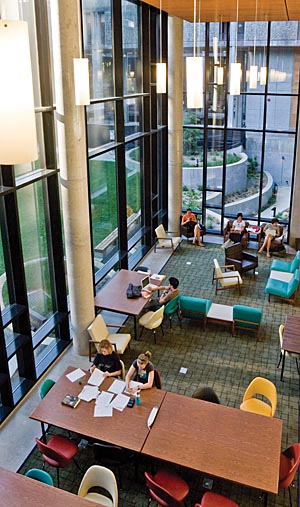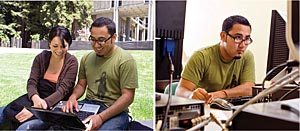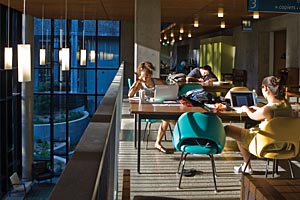When Raul Flores's father was a boy growing up in Mexico City, he loved going to the library, immersing himself in the knowledge contained in the books there, delighting in the feel of the pages, savoring their smell.
His dad instilled in Flores that same reverence for a library's offerings. But as a 21st-century college student, Flores, 21, goes to the library for much more than books.
A third-year sociology major from Mission Hills, Flores might hit the library's Media Center to check out DVDs or videotapes for class, including movies such as El Rojo Amanecer, about the Tlatelolco Massacre in Mexico City in 1968. He might then sit at one of the terminals in the Information Commons and search online databases for sociological articles. After working for a while, he typically meets up with friends at the library to work some more, chat, and hang out.
Libraries "are a lot more digital than they were in my parents' generation," says Flores. "Everything's a lot more interconnected."
Flores is part of a sweeping shift in how students use university libraries and, in turn, how libraries are redefining their role on college campuses.
Today's undergraduates--most born between 1986 and 1990--have come of age with the Internet, Google, cell phones, e-mail, RSS feeds, blogs, podcasts, file sharing, text messaging, laptops, PDAs, and wireless access. And university libraries must adapt to meet the demands of this new, digital age-and the expectations of a new, hyperconnected user.
"When I became a librarian, you pretty much had to go to a library to find out what they had," says UCSC University Librarian Virginia Steel. "Now, with resources like Google and other online services, you can just link to the contents of a library from anywhere."
In January, for example, UCSC became the first UC campus to loan a shipment of books from its library to the Google Books Library Project, which is scanning books to make the full text publicly searchable online.
But that doesn't mean that libraries, as physical presences, are disappearing.
| Related stories: The Dead live on at UCSC The $700,000 challenge |
At McHenry, a new annex has added 81,600 square feet of light-filled space in a modern, concrete-and-glass structure. Other renovations and enhancements include:
- An electronic research center with 60 stations to access library resources
- An instructional design center to help faculty make innovative use of technology in instruction and research
- A "cyber study" room and the Global Village café--an Internet café providing
social gathering space and online access
- Distance-learning facilities, providing support for students and faculty at remote locations, such as Silicon Valley
- Wireless networking throughout the building and outside
- Additional electronic workstations and a number of group study rooms to foster collaborative learning
Learning through collaboration
"Students collaborate much more in their learning than they did in the past," says Joan Lippincott, associate executive director of the Coalition for Networked Information in Washington, D.C.
In her observation, students today may be learning with others in a group, and may also have friends who are just there hanging out.
"In my generation, you had a social life in the dorm or wherever and an academic life in the classroom or library," says Lippincott, who labels herself a baby boomer. "Today's students have a much more fluid arrangement of academic and social life."
Libraries are also trying to pay attention to learning styles that depart from the traditional model of solitary reading, says Erika Linke, president of the Association of College and Research Libraries and associate dean of University Libraries at Carnegie Mellon University.
"Education today is characterized by people working together to collaborate," Linke says. "We're acknowledging different styles of learning, inquiry, and study."
For second-year UCSC community studies student Andres Rodriguez, UCSC's library is a far cry from the one he frequented in his hometown of Woodland.
"In college, people use it to socialize with other people," says Rodriguez, 20. He often uses the library for group study sessions for midterms and finals.
That's not to say McHenry, UCSC's Science & Engineering Library, and other, off-campus libraries aren't still quiet places for study and contemplation. But now, library staffs are creating both quiet zones and areas where people can be noisier, says Lippincott.
'Library 2.0'
Fifty to 100 years ago, libraries were designed around particular structures and schemes for organizing information, says UCSC's Steel.
"But with the advent of the web, people expect a more responsive and flexible type of structure," she says. "They've gotten used to ubiquitous Internet access."
To respond to the demand, UCSC Library staff decided last spring to embark on a "Library 2.0" initiative adapted from a program developed by a North Carolina librarian.
"There were a lot of new technologies such as instant messaging, wikis, blogging, and RSS feeds, and this was a way to get everyone on the library staff up to speed at the same time and think of ways to use these new technologies that were emerging," says Sue Chesley-Perry, digital initiatives librarian for both McHenry and Science & Engineering.
Now, librarians go where the students are, says Perry. For example, many librarians have Facebook pages to make themselves available for questions. And several librarians who teach research workshops for specific classes are using a blog instead of a web page.
Despite the many new technologies, books still have an important place in research, learning, and teaching.
"In my classes, I tell students how to find the different data-bases and how to use them," says Brij Lunine, a UCSC lecturer in writing. "But I still make my students get into the stacks because you often find the best stuff next to the book you were looking for."
Student Flores agrees that, despite the shift to an online research model, a physical library is still an important part of the culture.
"It sounds corny, but I'd like to see my kids come to an institution like this," says Flores, gesturing to the vaulted ceilings and book-filled shelves at McHenry Library.
Libraries' rapid shift from print to electronic media has raised a host of complex questions around intellectual property, ownership, licensing, and preservation. While those issues will have to be solved, that's part of the excitement of being a librarian at this particular juncture, says UCSC's Steel.
"We're poised between the old and the new, and every day brings with it new, interesting problems to think about," she says. "The whole information environment is changing so rapidly. It's really exciting to be part of this."
Photographer Phil Carter, 20, is a junior at UCSC, majoring in community studies.





